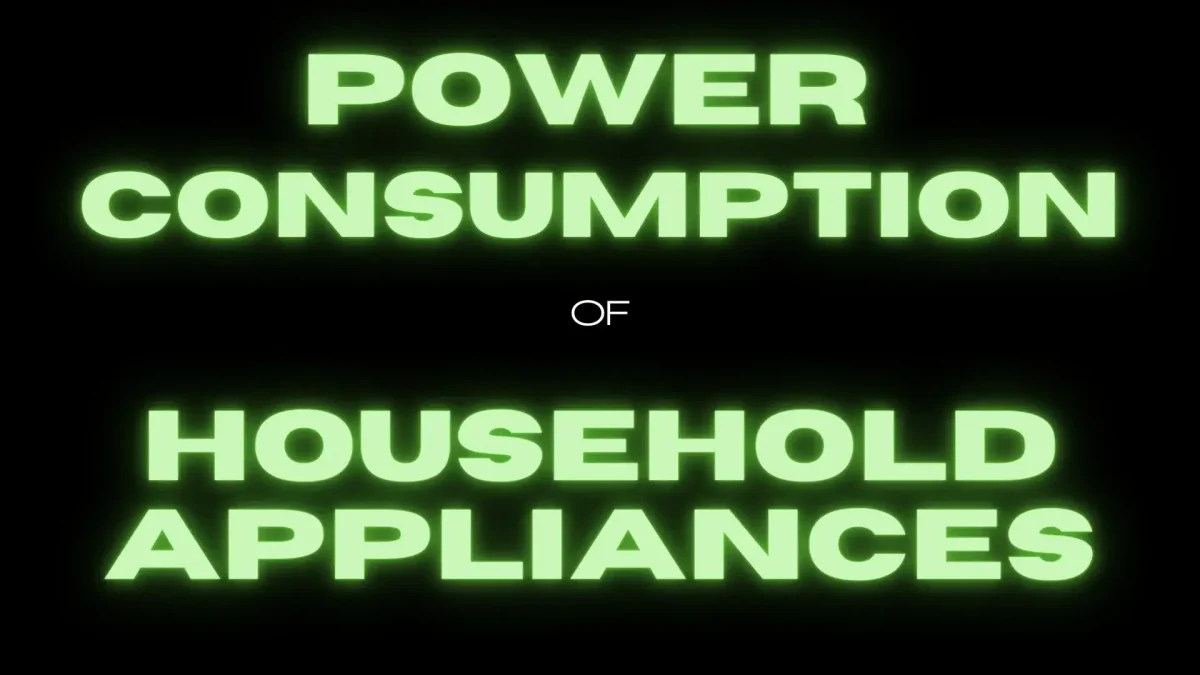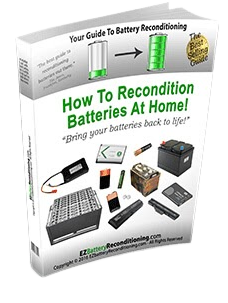We look at the average Power Consumption of Household Appliances. If you want to save energy or you are in an RV, here’s what you need to know
The power consumption of household appliances is an important consideration when making decisions about how to use energy efficiently. There are many types of household appliances, each with its own power consumption requirements.
Therefore, it is important to understand the power consumption of each appliance in order to make the most efficient decisions.
This article will provide an overview of the power consumption of several household appliances.
We have listed some of the most commonly used appliances with an estimate of their power consumption. This is intended for use as a guideline only.
Remember that a type of appliance’s power consumption will vary depending on its make and model. So, an Electrolux front load washer may have different requirements than an LG top loader.
Table of Contents
Wattage Table – Power Consumption of Household Appliances
Here’s the list
| ESSENTIAL APPLIANCES | ||
| Appliance | Rated (Running) Watts | Additional Surge Watts |
| 4 Light Bulbs (60W) | 240 W | 240 W |
| Dehumidifier | 700 W | 1200 W |
| Electric Blanket | 100 W | 1,250 W |
| Electric Water Heater (6 Gal.) | 1,650 W | 1,650 W |
| Fan | 180 W | 180 W |
| Furnace Fan (1/3 HP) | 700 W | 1,350 W |
| Heating Pad | 60 W | 60 W |
| Space Heater | 1,500 W | 1,500 W |
| LAUNDRY APPLIANCES | ||
| Appliance | Rated (Running) Watts | Additional Surge Watts |
| Clothes Dryer | 5000 W | 6500 W |
| Clothes Washer | 1,200 W | 2,400 W |
| Iron | 1,100 W | 1,100 W |
| Vacuum | 900 W | 900 W |
| GROOMING / PERSONAL CARE | ||
| Device | Rated (Running) Watts | Additional Surge Watts |
| Curling Iron | 200 W | 200 W |
| Electric Toothbrush | 3 W | 3 W |
| Blow Drier (Hair) | 1,500 W | 1,500 W |
| Nose Hair Trimmer | 2 W | 2 W |
| Shaver | 11 W | 11 W |
| KITCHEN APPLIANCES | ||
| Appliance | Rated (Running) Watts | Additional Surge Watts |
| Air Fryer | 1,600 W | 2,200 W |
| Blender | 350 W | 800 W |
| Chest Freezer | 350 W | 600 W |
| Coffee Maker (2 cups) | 500 W | 500 W |
| Corn Popper | 1,200 W | 1,200 W |
| Refrigerator | 500 W | 700 W |
| Electric Frying Pan | 1,500 W | 1,500 W |
| Grill (Electric) | 1,500 W | 1,650 W |
| Hot Plate | 1,800 W | 2,200 W |
| Microwave (635W Cooking Power) | 635 W | 800 W |
| Slow Cooker | 200 W | 290 W |
| Toaster | 1,500 W | 1,500 W |
| Toaster Oven | 1,400 W | 1,400 W |
| Waffle Iron | 1,200 W | 1,750 W |
| ENTERTAINMENT | ||
| Device | Rated (Running) Watts | Additional Surge Watts |
| 19″ Color TV | 40 W | 40 W |
| 27″ Color TV | 60 W | 60 W |
| 32″ Color TV | 85 W | 85 W |
| Battery Charger (Cell Phone) | 5 W | 5 W |
| CD/DVD Player | 100 W | 100 W |
| Clock Radio | 1 W | 1 W |
| Desktop Computer | 70 W | 70 W |
| Laptop | 50 W | 50 W |
| Inkjet Printer | 30 W | 30 W |
| Radio 2-Way | 5 W | 5 W |
| Satellite Dish & Receiver | 30 W | 30 W |
| Stereo | 90 W | 90 W |
| TOOLS | ||
| Item | Running Wattage (W) | Additional Watts |
| 12′ Concrete Cutter | 2,000 W | 2,000 W |
| 1/4′ Drill | 280 W | — |
| 7 1/4′ Circular Saw | 1,600 W | 1,600 W |
| Air Compressor (Average) | 2,200 W | 2,200 W |
| Belt Sander | 1,000 W | — |
| Circular Saw | 1,250 W | 1,250 W |
| Disc Grinder | 2,000 W | 2,000 W |
| Disc Sander | 1,200 W | — |
| Electric Edger | 950 W | 1,450 W |
| Electric Chainsaw | 1,250 W | 1,250 W |
| Electric Mower | 1,500 W | 2,900 W |
| Electric Pressure Washer | 1,200 W | 2,400 W |
| Electric String Trimmer | 450 W | 850 W |
| Jig Saw | 650 W | 1050 W |
| Inflator Pump | 50 W | 150 W |
| Miter Saw | 850 W | 1,300 W |
| Orbital Sander | 600 W | 1,200 W |
| Paint Sprayer | 400 W | 800 W |
| Planer | 950 W | 1,450 W |
| Water Pump | 950 W | 1,950 W |
| Wet / Dry Vacuum | 900 W | 1,600 W |
| Worm Drive Saw | 1,600 W | 1,550 W |
| Winch | 1,700 W | 3,500 W |
| FURNACE FAN FUEL / GAS OIL FURNACE | ||
| Item | Running Wattage (W) | Additional Watts |
| 1/8 horsepower (hp) | 250 W | 150 W |
| 1/6 horsepower (hp) | 550 W | 300 W |
| 1/4 horsepower (hp) | 600 W | 400 W |
| 2/5 horsepower (hp) | 750 W | 750 W |
| 3/5 horsepower (hp) | 900 W | 1500 W |
| CENTRAL AIR CONDITIONING | ||
| Item | Running Wattage (W) | Additional Watts |
| 10,000 BTU | 1500 W | 700 W |
| 20,000 BTU | 2,400 W | 700 W |
| 24,000 BTU | 3,800 W | 1,200 W |
| 32,000 BTU | 5,000 W | 1,600 W |
| 40,000 BTU | 6,000 W | 750 |
| RV AIR CONDITIONING | ||
| Item | Running Wattage (W) | Additional Watts |
| RV Roof-Top AC (7,000 BTU) | 600 W | 600 W |
| RV Roof-Top AC (11,000 BTU) | 1,000 W | 800 W |
| RV Roof-Top AC (13,500 BTU) | 1,500 W | 1,200 W |
| RV Roof-Top AC (15,000 BTU) | 2,000 W | 1,500 W |
Categories of Power Consumption
Let’s take a look at some of the appliances you might be using.
Lighting

Generally, lighting power consumption is as follows.
Incandescent bulbs: We use incandescent bulbs in our houses, and they consume more power than other types. They need 60-100 watts of power and are becoming less popular for that reason.
Halogen bulbs: Halogen bulbs consume less power than incandescent bulbs. But they still need a significant amount of power. They typically use 20-50 watts of power.
Compact fluorescent lights (CFLs): CFLs are more expensive to buy than incandescent bulbs but will save you money on your bills.
Light-emitting diodes (LEDs): LEDs are becoming increasingly popular due to their energy efficiency and long life. They typically require only 4-7 watts of power.
Kitchen Appliances
Refrigerators: Refrigerators usually need a large amount of power to keep your milk cold. The power needed depends on the size of the fridge. But generally, a refrigerator will need between 500-700 continuous watts. If you are lucky enough to live in a cold place like Alaska, keep your milk on the back step in the winter and save some cents.
Dishwashers: Dishwashers need a large amount of power to run. Between 1,200-2,000. It is worth experimenting with the lowest setting on the appliance to reduce power usage. Most modern units have an “Eco-Mode” feature that will reduce power consumption. Also, try putting it on half-full mode if it has one. This still gets the contents super clean, using less energy.
Ovens: Ovens are one of the least energy-efficient appliances in the kitchen. A typical oven will consume 2,400 watts of power. Microwaves and air-fryers use less power, ranging from 500-1,600 watts.
Self-cleaning ovens are more efficient than traditional ones due to their superior insulation.
Some newer ovens may also consume less power, so it’s worth researching your specific model. Remember, you will only use your oven for a couple of hours a day so it may not be as power-hungry as you would imagine.
Smaller Kitchen Gadgets
Electric kettles: Electric kettles consume a large amount of power but only for a short time. Most modern electric kettles consume between 1,500-2,000 watts of power. This depends on how full the kettle is, so avoid overfilling to save energy. The power of kettles boiling impacts the national grid when a popular show finishes.
Coffee makers: Coffee makers vary in power usage, depending on their capacity. Most standard coffee makers will consume between 800-1,000 watts. But some larger machines can consume up to 1,500 watts or more.
Toasters and toaster ovens: The same applies to them. High Wattage but generally for a shorter time.
Laundry Appliances
Washing Machines: Washing machines vary in power consumption, depending on the type of machine. Front-loading machines need between 500-800 watts while top-loading machines need a little more.
Clothes Dryers: Dryers also need a significant amount of power. A typical dryer will use around 3,000-4,000 watts of power. The combination of the motor to turn the drum and the heater to dry the clothes guzzles power.
Grooming Appliances
We all like to look our best, and if you are anything like me, you make use of various appliances to make it so.
Tools like nose trimmers, electric razors, and toothbrushes use tiny amounts of power. Sometimes, in single figures for wattage.
But anything that generates heat needs a lot more power. So, if you use curling irons, hair dryers, or straighteners, keeping an eye on the electricity drain is sensible.
Hair dryers: Hair dryers need significant power to operate, between 1,000 and 1,800 watts.
Hair straighteners: Hair straighteners usually need around 100-200 watts of power.
Electric toothbrushes: Electric toothbrushes need a tiny amount of power, around 3-10 watts of power.
Power requirements for outdoor living
Outdoor living is another activity for which it is crucial to be aware of your power usage. When camping or boating, it can be vital to know how much power is available and how much each appliance will use.
You will generate your power from a portable generator or sometimes from deep-cycle batteries. So you need to know the power requirements of your appliances so you don’t overload your power source.
Air conditioners: An air conditioner is one of the most power-hungry appliances when outdoors. And when you are in an RV in Arizona or New Mexico, it can turn into a huge oven. This makes good aircon essential. An RV air conditioner needs between 3,000 to 5,000 watts of power, depending on the BTU. This depends on your RV’s make and model, so be sure to check the specs in your owner’s manual.
TVs: A TV is another appliance that can use a decent amount of power, but not as much as you might think. An LED flat-screen TV needs 150 watts or more. This will depend on the size of the TV, which, in turn, usually depends on the size of your RV.
Tools
Power tools like drills, saws, and other tools that need motors may use up to and beyond 1,000 watts of power.
Building work, by its nature, often occurs in remote locations without mains electricity. So, builders often need a generator to run their equipment.
So, you need to know how much power each tool consumes. That way, you can ensure that the generator does not become overloaded. You will need to know what tools you will be using and which tools will be in use at the same time.
Conclusion – Power Consumption of Household Appliances
The power consumption of appliances varies, depending on the type and size of the appliance.
An understanding of the power needs of each appliance helps to decide how to use energy. You can reduce consumption by choosing energy-efficient appliances. Or you can reduce the power needs of the appliance by putting it on a lower setting. This can help you save money and energy.
Before You Go …
You’ve learned a lot about the power consumption of household appliances and gadgets in this article. But do you know how much power your RV needs? Or whether it can power the appliances and gadgets you take away? If you’re planning a road trip or camping adventure, you’ll want to make sure you have enough electricity to run all your devices and appliances comfortably. That’s why you need a reliable RV generator.
But not all RV generators are created equal. Some are too noisy, too heavy, or too expensive. Others may not have enough power output, fuel efficiency, or portability. How do you choose the best one for your needs?
That’s where our next article comes in handy. We’ve researched and tested for you and compiled a list of the top 5 best 30A RV generators available today. We’ll also show you how to choose the right one for your RV size, budget, and preferences. You’ll learn about the pros and cons of each model, the features to look for, and the best places to buy them.
Don’t miss this opportunity to find the perfect RV generator for your next trip. Click here to read our ultimate helpful guide on the best 30A RV generators. Trust me, you won’t regret it.
Like Power Consumption of Household Appliances? Check out our Related Articles


